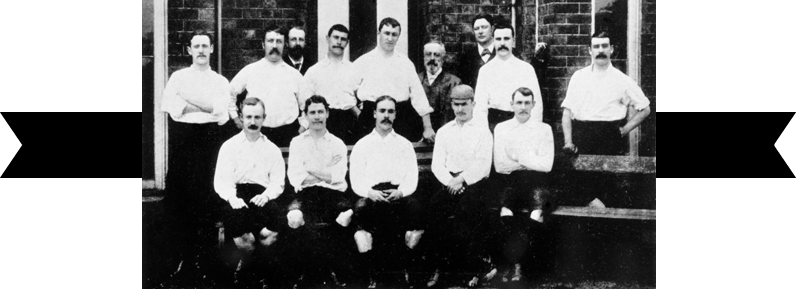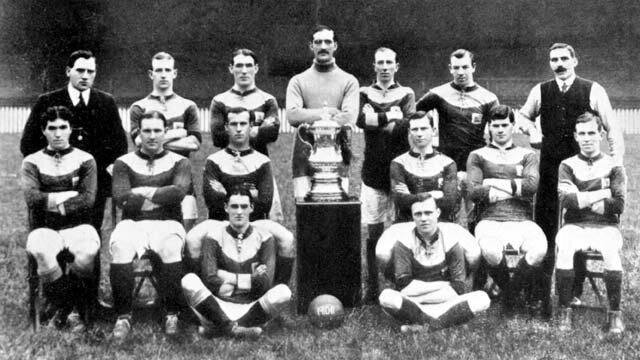1888 to 1914

Establishing the Template
By Phil Shaw
These were comparatively primitive times, when players did not wear shirt numbers and stayed on the pitch at half-time; goalkeepers sported the same tops as outfield players; and two umpires officiated the game, referring only occasionally to a touchline referee. The introduction of the penalty kick was three years away, as were goal-nets to prevent the frequent disputes over whether the ball had passed between the posts.
The first season’s fixtures had been drawn up as late as 23rd July 1888. Another fact that will raise eyebrows today is that the League programme had been running for 11 weeks before the system of two points for a win and one for a draw was agreed upon (some of the 12 founding clubs had argued that points should be awarded only for a victory).
First things first
So, what other League 'firsts' can be verified? The first 10,000 attendance came for Everton’s 5-2 defeat of Accrington at Anfield – yes, Anfield, their original home before relocating to Goodison Park - where there was another late kick-off due to the tardiness of the visiting team.
Accrington’s John Horne suffered a cracked rib and became the first goalkeeper replaced by a team-mate (substitutes were not sanctioned until 1965).
A week later came The Football League’s first 10-goal thriller, if you will – a 5-5 draw between Blackburn and Accrington -- and Rovers’ first scorer, Jack Southworth, went on to play violin in the Halle Orchestra.
The first player cautioned was a Scot, Alec Dick, of Everton, “for striking a Notts County player and using foul language”, offences for which he publicly apologised. In the early years of association football, hacking was still a widespread means of dispossessing an opponent. Perhaps with that in mind, William McGregor said proudly in 1891 that “not a single fatal accident” had been recorded.
The first transfer between League clubs had not been long in coming either, Preston’s Archie Goodall switching to Aston Villa in October ’88. Although no fee changed hands, McGregor, who was also a Villa director, made it clear he opposed such deals.
The Father of the League would have been even less impressed, one suspects, by the 'market' in players that swiftly developed. When Dan Doyle left for Celtic in 1892 it was reported that Everton sought to lure him back with wages of £5 per week - and the tenancy of a pub.
Villa were the League’s first runners-up, Stoke the first wooden spoonists although they were re-elected at the annual meeting in 1889. Of the new applicants, Newton Heath, who became Manchester United, received a solitary vote.
Stoke’s reprieve was short-lived. At the end of the second season they lost their place and joined the Football Alliance, formed by clubs aspiring to League status. In came Sunderland, signalling the end of the even split between six Midland clubs and six from Lancashire.
The League's expansion continued into Yorkshire in 1892, when it was agreed to have a 16-club First Division and a 12-strong Second Division. Sheffield Wednesday, representing the city renowned as 'the cradle of football', were voted in with Nottingham Forest, and Newton Heath.
The south remained virgin territory for the League for another year. Woolwich Arsenal, from south-east London, then became members, as did Newcastle United and Liverpool (who replaced Bootle, thereby ending the first fierce Merseyside rivalry, between Bootle and Everton, and launching another).

The 1905 Woolwich Arsenal team
Modern problems
Newcastle’s first game was away to Arsenal, the sort of pairing which would set 21st-century observers quipping about the mischievousness of the fixture computer. After travelling by overnight train and going sight-seeing in the capital, some players were said to be asleep when they arrived at the ground in Plumstead. They drew 2-2 before the long haul back to the north-east.
With the two-tier League came Test matches, a kind of Victorian play-off system to decide promotion and relegation. At the end of 1892/93, Newton Heath stayed up by beating Small Heath (later Birmingham City) in one such game. However, the Tests were discredited in 1898. Stoke and Burnley -- both knowing a draw would ensure survival for one and promotion for the other -- acted out a mutually convenient barren stalemate without a single shot on goal. Automatic promotion and relegation was promptly introduced.
Preston were to retain the title won in that first season and finished second in the next three campaigns. Yet having proposed the commissioning of the handsome Football League championship trophy, they never actually lifted it.
Rival powers poured into the void. Sunderland, dubbed 'The Team of All the Talents', were champions in only their third season, 1892/93, repeating the feat two years later. Aston Villa won five championships (and three FA Cups, including the double in 1897) before Queen Victoria’s death in 1901 – when Liverpool, nine years after their formation, took their first title. Notts County were the only one of the 12 founder members to finish in the top six.
Another measure of the pace of change that year was Preston’s relegation. One of their directors, Tom Houghton, proposed that the League increase the First Division to 20 clubs, thereby keeping the one-time Invincibles up. He was unsuccessful.
The West Riding of Yorkshire was then a rugby league stronghold. The Football League’s desire to make inroads there was underlined by the election of Bradford City to the Second Division in 1903 before they had so much as played a game.
The first of many for United
Five years later, City were in the First Division and by 1911 their claret and amber ribbons adorned the FA Cup. In the final they beat Newcastle, who themselves went from issuing statements bemoaning the lack of support to carrying off the championship trophy in 1904/05, 1906/07 and 1908/09. In between the second and third of those triumphs came Manchester United's first title. By 1910, United had moved to Old Trafford - and the rest is history.

The 1911 FA Cup winning Bradford City team
Newcastle's third title was tarnished by an incredible 9-1 home loss to Sunderland. The Tyne-Wear reserve derby was being contested simultaneously at Roker Park, where the man deputed to post the score from St James’ Park was attacked when it reached 1-7. Locals assumed he was making it up.
While Newcastle were pre-eminent in importing Scots, their captain, Colin Veitch, was a Geordie. The England international was also a playwright, composer and conductor, chairman of the Players' Union, and later a journalist independently minded enough to incur a ban from the St James’ press enclosure.
The final season before the Great War, 1913/14, showed how far The Football League had come since Gershom Cox’s misfortune set the ball rolling. Blackburn were champions, Preston went down again and Chelsea, formed less than a decade earlier, finished eighth.
Curiously, two of the today’s great powerhouses, Manchester City and United, were locked together on points in 13th and 14th place respectively, as were Everton (15th) and Liverpool (16th). In the Second Division, Bradford Park Avenue pipped Woolwich Arsenal and Leeds City to second spot behind Notts County.
Many of the England's finest went off to engage in an altogether more deadly conflict, but the template for the greatest League in the world had been established.